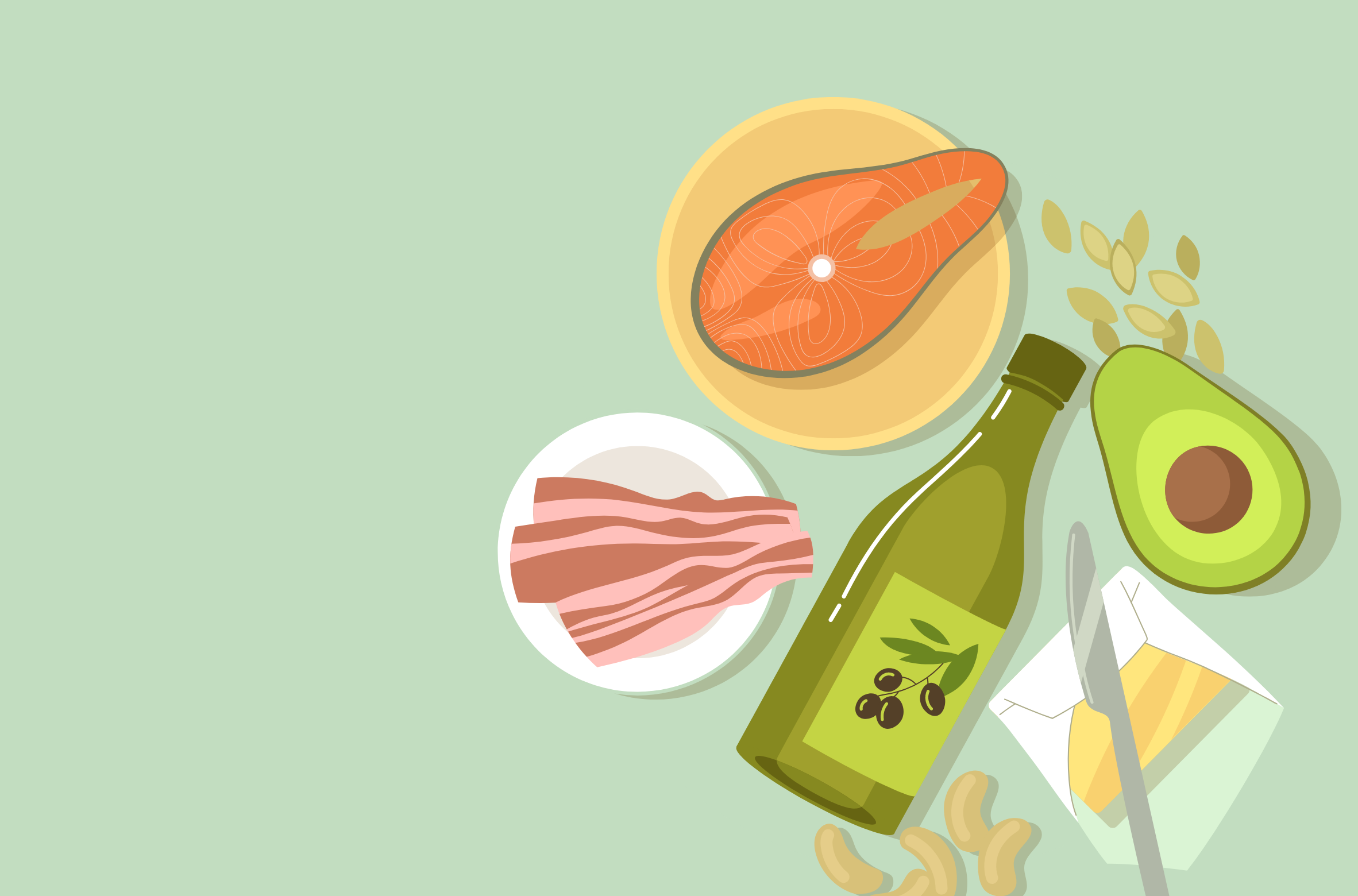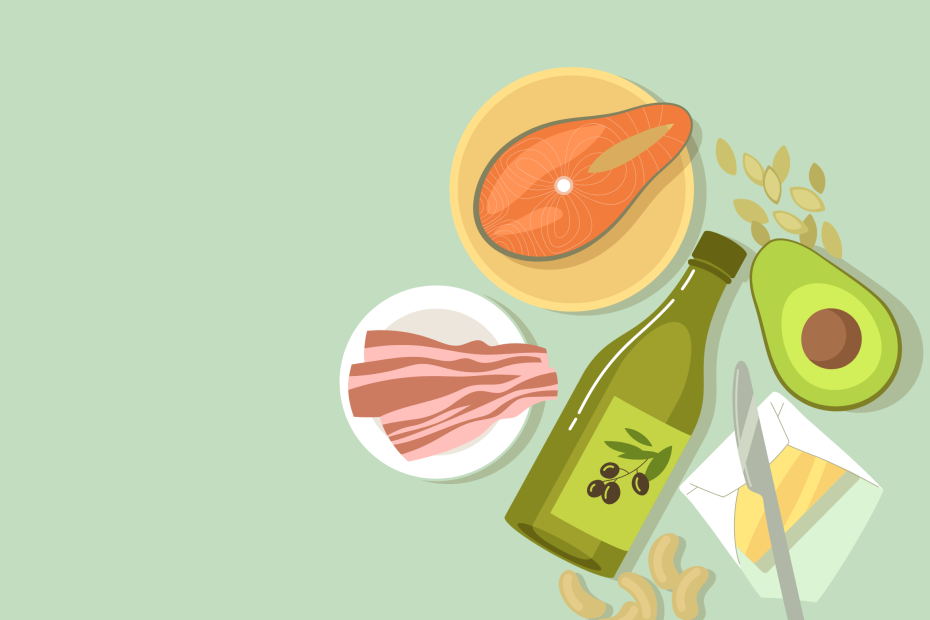Is fat in fashion again?
For most of the 20th century, low-fat diets were promoted by physicians and scientists as being healthier than diets with more fat. This was based on research beginning in the 1940s that found correlations (links) between low-fat diets, cholesterol, and heart disease. Over time, the idea became widespread that low-fat diets were the healthiest.
But, as the saying goes, “correlation is not causation”—meaning that just because two things happen together (eating lots of fat, having a heart attack)—doesn’t mean that one causes the other. In the 1990s, more and more researchers began noticing that people on high-fat diets didn’t necessarily develop heart disease. And people on low-fat diets or with normal cholesterol could still have heart attacks. So researchers began to reexamine the idea that fat is bad for us.
Today, the view is that the type of fat we consume is at least as important as the amount.
Fats 101
There are four major types of fat in food:
- Saturated fats
- Monounsaturated fats
- Polyunsaturated fats
- Trans fats
Saturated fats mainly come from animal sources and are solid at room temperature. (Think of butter, lard, or cooled bacon grease.) They are considered less healthy because they elevate “bad” cholesterol. (We’ll get into cholesterol farther down.) Saturated fats also promote inflammation in the body, which can worsen conditions like arthritis, diabetes and heart disease.
If it helps you remember that saturated fat is unhealthy, you can picture it hardening blood vessels, raising the risk of heart attack and stroke.
Unsaturated fats are derived from plant sources (vegetable oils, nuts, and seeds) and are liquid at room temperature. They are considered healthier because they elevate “good” cholesterol.
Exception: Despite being plant-based, coconut oil and palm oil actually contain saturated fats.
Picture these liquid fats keeping your blood vessels supple and unclogged.
Trans fats are created by processing unsaturated fats to make them solid and therefore more like saturated fats. This makes them unhealthy. Shortening, such as Crisco, is an example of a trans fat. Trans fats are found in many pre-made and packaged foods, especially baked goods, like cakes and cookies. Check nutrition labels to see if a product contains trans fats. But be aware: In the US, food makers can claim a product has 0 (zero) grams of trans fat if the amount in the product is less than 0.5 g of trans fat per serving. To be on the safe side, look at the ingredient list for the phrases “fully hydrogenated,” “partially hydrogenated,” and “hydrogenated” (example: hydrogenated palm oil) to see if a product actually does contain trans fat.
A Closer Look: Saturation
The term “saturated” refers to how packed with hydrogen atoms a fat molecule (also called a lipid) is. If the fat molecule’s hydrogens are densely packed, and each is connected to the one next to it with a single chemical bond, it’s considered saturated.
If the molecule has even one double bond between neighboring hydrogens, it’s considered monounsaturated (“mono” meaning one). And if it has more than one double bond, it’s considered polyunsaturated (“poly” meaning many).
The saturation also tells us how solid the fat will be at room temperature. Saturated fat, packed tightly with hydrogens, is solid at room temperature.
Unsaturated fat, with fewer hydrogen atoms packed in, is liquid at room temperature.
Cholesterol
It would be understandable if you thought of cholesterol as a bad thing. As part of the low-fat diet movement, cholesterol has often been villainized. But our bodies actually need cholesterol, a waxy substance that helps build cells as well as make vitamins and hormones. In fact, the liver makes all the cholesterol the body needs. We also get it from animal-based foods.
It only becomes a problem when we get too much of it, and it begins to build up on the walls of our arteries, making them narrower and less flexible. If blood forms clots in these narrow passageways, a stroke or heart attack can result.
So how do we get the benefits of cholesterol without the drawbacks? It’s a matter of balance: There is “good” cholesterol and “bad” cholesterol, and we want to make sure we get more of the good kind and less of the bad kind.
LDL (low-density lipoprotein) is considered the bad cholesterol, because it can build up in arteries and cause chronic inflammation, increasing our risk for a variety of diseases. It’s found in saturated fats and trans fats.
HDL (high-density lipoprotein) is considered the good cholesterol, because it carries LDL from the arteries back to the liver for disposal, and so lowers our disease risk. It’s found in unsaturated fats.
When we have our cholesterol levels checked with a blood test (“lipid panel”), the test is measuring how much of each type of cholesterol, plus fats known as triglycerides, is circulating in the blood. (Triglycerides are the most common type of fat in the body, and are made when we use fewer calories than we take in. When not circulating in the blood, they are stored in our fat cells.)
Pro Tip: Fatty fish like salmon, sardines, and mackerel—as well as walnuts and flaxseeds—are rich in health-promoting polyunsaturated fats called omega-3 fatty acids. Eating these foods can boost good cholesterol (HDL).
How Much Is Okay to Eat?
The USDA’s Dietary Guidelines for Americans recommends that we get 20% to 35% of our daily calories from fat (children under the age of 4 can get 30-40%), of which less than 10% should be saturated fat.
Fun Fact: Which weighs more, a pound of muscle or a pound of fat? This is a trick question, because they both weigh one pound! But: muscle is more dense than fat. So the pound of muscle will take up less volume than the pound of fat.
The Bottom Line
Whenever you feel overwhelmed by nutritional information, just remember a few key things. When you have a choice:
- Prioritize unsaturated fat (vegetable oils, nuts, and seeds; avocados)
- Limit saturated fat (animal-based products, packaged foods with trans fats) to less than 10% of your daily calories
- Avoid trans fats
Sources:
American Heart Association (types of fat, cholesterol)
Cleveland Clinic (cholesterol numbers, inflammation, chronic inflammation)
Harvard School of Public Health (fats and cholesterol, omega-3 fatty acids)
US Dept of Agriculture (dietary guidelines, especially table on page 133)
Journal of the History of Medicine and Allied Sciences (history of low-fat guidance)
Mayo Clinic (types of fat, triglycerides, dietary guidelines)
 share
share



